| کد مقاله | کد نشریه | سال انتشار | مقاله انگلیسی | نسخه تمام متن |
|---|---|---|---|---|
| 2957727 | 1178189 | 2014 | 5 صفحه PDF | دانلود رایگان |
BackgroundCardiac resynchronization therapy (CRT) reduces the mortality rate among patients with advanced heart failure (HF) and a wide QRS complex. Despite such clinical improvement, the clinical features of ventricular tachyarrhythmias (VA) and the risk of sudden cardiac death (SCD) among these patients still remain to be elucidated.MethodsIn total, 128 consecutive patients with advanced HF (mean age, 68±10 years; 90 men; mean left ventricular ejection fraction [LVEF], 27±7%) who underwent CRT with a cardioverter-defibrillator (CRT-D) as the primary prevention for SCD were examined. Twenty-nine patients had ischemic cardiomyopathy (ICM), whereas the other 99 patients had nonischemic cardiomyopathy (NICM). At each follow-up examination, patient- and device-related data were collected. All detected VA episodes were analyzed.ResultsDuring a mean period of 1009±566 days, 30 patients (23%) experienced appropriate cardioverter-defibrillator treatment for sustained VA. Twenty-six had NICM and the other 4 had ICM. The first VA episodes mostly involved monomorphic ventricular tachycardia (VT) at 187±30 beats/min (28 patients, 93%). The mode of successful therapy was antitachycardia pacing (ATP) in 60% of patients. Multiple linear regression analysis revealed that among clinically plausible predictors (age; gender; LVEF; underlying rhythms; QRS duration; QT interval; ischemic cause of HF; history of nonsustained VT; and the uses of amiodarone, β-blockers, and renin-angiotensin inhibitors), only the history of nonsustained VT (P<0.0001) was a significant predictor of appropriate cardioverter-defibrillator therapy.ConclusionsAfter implantation of a CRT-D device for primary prevention, VAs were more prone to occur in patients with nonischemic HF than in those with ischemic HF. Moreover, the first VA episodes were mostly monomorphic VT, and most episodes were terminated by ATP. In addition, nonsustained VT was a potent predictor of VA after CRT.
Journal: Journal of Arrhythmia - Volume 30, Issue 5, October 2014, Pages 367–371
